**Note: Most beadlock wheels are designed exclusively for off-road use and are not street legal in many regions. Always consult local Department of Transportation (DOT) regulations and guidelines to ensure proper and lawful use on public roads.
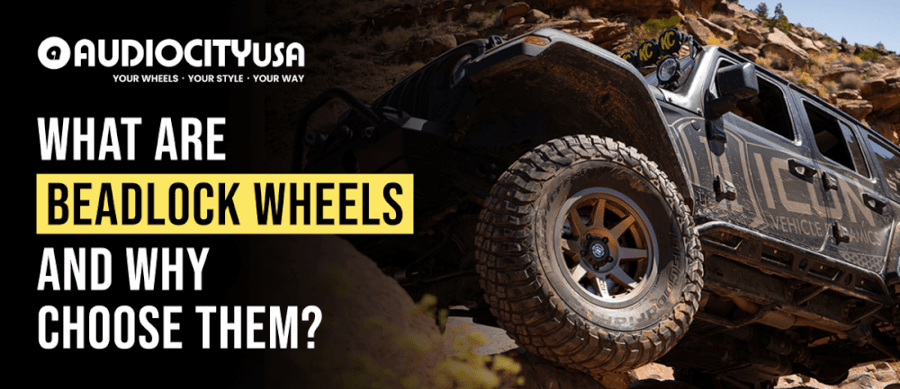
If you’re an off-road enthusiast pushing your vehicle to the limits, you’ve likely heard of beadlock wheels. These rugged rims are a game-changer for off-road performance and even certain racing applications, offering traction and security that ordinary wheels can’t match. But what exactly are beadlock wheels, how do they work, and why might you choose beadlock wheels for your build?
In this comprehensive guide, we break down everything you need to know – from the unique design of beadlock wheels and their pros and cons, to their use in different driving contexts (off-roading, racing, heavy-duty work, etc.). By the end, you’ll understand why these bead lock rims have become the off-roader’s secret weapon and how to choose the right set for your vehicle. Let’s dive in!
What Are Beadlock Wheels?

Beadlock wheels (aka bead lock rims) are purpose-built for serious performance. Their job? To literally lock the tire’s bead—that inner edge of the tire that sits on the rim—so it stays firmly in place, no matter what punishment you throw at it.
Where Regular Wheels Fall Short
On standard wheels, air pressure alone holds the bead against the rim. That’s fine for everyday driving. But drop the PSI for off-roading or launch a drag car under high torque, and that bead can slip—or worse, pop right off. Enter: beadlock technology.
How Beadlock Wheels Work
Beadlock wheels use a mechanical clamping ring to physically secure the tire to the wheel. You’ll spot them instantly by the bold ring of bolts circling the outer lip. These bolts tighten a metal ring that sandwiches the tire bead against the rim, creating an ultra-secure grip that standard wheels just can’t match.
With this setup, the tire won’t de-bead—even at single-digit PSI or under extreme stress. That means more traction, more control, and zero worry when you’re pushing limits.
Where They Shine
Originally made for hardcore rock crawlers and desert racers, beadlocks have become a go-to upgrade for:
● Off-road trucks & Jeeps
● UTVs & trail rigs
● Drag cars & high-power launches
Any vehicle running low pressure or aggressive driving can benefit. Bottom line: beadlock wheels give you security where it counts, making them a must-have for anyone who plays rough in demanding terrain or on the track.
DOT Guidelines and Regulations for Beadlock Wheels
In the United States, beadlock wheels generally do not meet Department of Transportation (DOT) standards for street use, as they have not been tested and approved for on-road applications. The DOT requires wheels used on public roads to have specific bead retention standards and construction methods, typically involving traditional air-pressure-based bead seating rather than mechanical clamping methods.
While individual state regulations vary, most states enforce DOT standards and prohibit street-driven vehicles from using beadlock wheels due to safety concerns associated with potential loosening of bolts, air leaks, and improper installation. Law enforcement agencies may issue citations if beadlock wheels are used on public roads where not explicitly permitted.
If you consider beadlock wheels, it’s critical to:
● Check with your local state’s DOT guidelines to confirm if beadlock wheels are permitted for street use.
● Use beadlock wheels primarily for off-road or racing applications, transporting the vehicle via trailer if required.
● Ensure proper installation, regular maintenance, and periodic torque checks of beadlock hardware to maintain safety.
When in doubt, consult directly with your state’s DOT office or local vehicle enforcement authorities to ensure full compliance.
Under the Ring: How Beadlocks Work
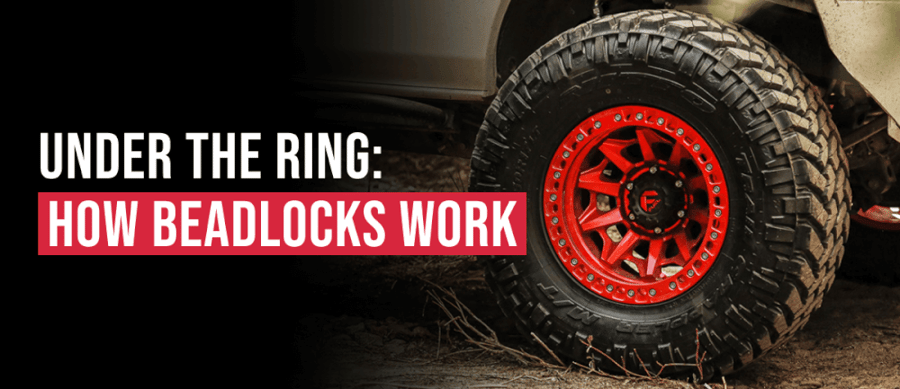
Beadlock wheels are designed to physically hold your tire in place, so it doesn’t slip off the wheel, even when running super low air pressure. Here’s a simplified breakdown of how a typical single beadlock wheel does its job:
● Outer Clamping Ring: Around the outside of the wheel, there’s a thick metal ring. This ring bolts directly to the wheel using a series of strong bolts (usually 12 to 24). When mounting the tire, the outer edge of the tire (called the “bead”) is placed between this ring and the rim of the wheel, kind of like putting the tire in a clamp.
● Inner Wheel Lip: The inside edge of the tire sits like it normally would, pressed against the inner lip of the wheel. Many beadlock wheels add little ridges or textures here to help grip the tire better. So while the inside bead stays put naturally, the outside bead gets locked down by the ring.
● Bolts and Tightening: Once the tire is in place, the outer ring is slowly bolted down evenly. This squeezes the tire’s outer edge tight between the ring and the wheel, kind of like tightening the lid on a jar. Tightening the bolts in a crisscross pattern is important to keep everything even. When done right, the tire is firmly locked in place and won’t budge.
● Final Result – Tire Locked to the Wheel: After tightening, the tire is clamped so tightly it can’t slip off, even at very low air pressures (like 5–10 PSI). The inside edge is held by the wheel, and the bolted ring grips the outside. In extreme setups (like military vehicles or hardcore rock crawlers), some wheels even have rings on both sides, but most beadlock wheels only clamp the outside.
On a regular wheel, your tire is only held in place by air pressure and a snug fit. That works fine—until you air down too much or put a lot of stress on the tire. Then the tire can pop loose. Beadlock wheels fix that by giving the tire a mechanical lock, not just relying on air to keep it in place. Think of it as bolting the tire to the wheel for maximum security.
Why Beadlocks Dominate Off-Road
If your weekends mean crawling boulders, slinging mud, or floating across dunes, beadlock wheels are your ride-or-die. They’re built for one thing: keeping your tire locked in place when the terrain gets nasty.
The Problem with Low Tire Pressure
Off-roaders know the secret to max traction is airing down your tires. Lower pressure = bigger footprint = more grip. But here’s the catch:
● Go too low, and a standard rim can’t hold the tire.
● One sharp turn or bump at 10 PSI can cause the bead to pop off the rim.
● Once de-beaded, good luck reseating that tire on the trail.
Beadlock wheels eliminate the risk. They clamp the tire in place so it won’t slip, no matter how low your PSI drops. Want to run 5, even 3 PSI? Go for it. Beadlocks are built for it.
● Factory wheels typically bottom out around 12–15 PSI.
● Beadlocks? They thrive in single digits, without losing the tire.
● The tire molds over terrain like a tank tread, delivering insane traction and unbeatable control.
Where Beadlocks Make All the Difference
When terrain gets technical and tire pressure drops low, ordinary wheels just can’t keep up. This is where beadlocks prove their worth—delivering grip, durability, and control where standard setups fall short. Let’s break down exactly where these trail-tested warriors shine the brightest.
Rock Crawling
Picture your Jeep clawing through a jagged rock garden.
● Beadlocks let you air down low so the tires wrap around rocks.
● The ring keeps the tire glued to the wheel—zero bead slip.
● You crawl harder, grip longer, and conquer more.
Mud Bogging
Knee-deep in a sloppy, rutted pit? No problem.
● Low pressure helps tires spread out and grip slick terrain.
● Beadlocks stop “burping” or losing the bead during throttle bursts.
● You stay planted and power through without losing traction.
Desert Dunes & Sand Trails
In soft sand, flotation is everything.
● Drop your PSI to ~10 or below without fear.
● Beadlocks keep the bead locked in, even while cornering or landing jumps.
● Air down and stay down, even in the softest dunes.
Built for Abuse—and Built to Last
Beadlocks don’t just enhance performance—they add protection:
● They help prevent sudden tire loss or blowouts after hard hits.
● The bolted ring acts as armor, shielding your wheel’s outer lip.
● Many rings are replaceable—gouge one on the rocks? Swap it out, not the whole wheel.
Trusted by the Best
When the stakes are high and the terrain gets brutal, pros don’t gamble—they run beadlocks. From competition-level crawlers to elite desert racers, the toughest builds in the game trust beadlocks to hold the line.
And when it comes to wheels that can take the hit and keep you moving, these brands lead the charge:
● Method Race Wheels – home of the race-proven 105 beadlock.
● Raceline – makers of the legendary Monster series.
● Fuel & KMC – with tough, stylish options that don’t just perform, they intimidate.
🎯 Pro Tip: AudioCityUSA carries a full lineup of these off-road champions. Whether you’re building out a Jeep, truck, or UTV, we’ve got the beadlocks that’ll turn heads and tear up trails.
Beyond the Trail: Racing & Heavy-Duty Applications
While beadlock wheels are best known in off-road circles, their value extends well beyond the trail. In high-stress environments—from motorsport to military use—they offer critical reliability and performance when conventional wheels fall short.
Drag Racing
Maintaining tire stability is essential in high-horsepower drag racing. Drag slicks are often run at low air pressure to improve traction off the line.
Under intense acceleration, this setup can cause tires to rotate on the rim—or worse, unseat from the wheel entirely.
Beadlock wheels prevent this by mechanically clamping the tire bead, ensuring the tire and wheel remain securely connected throughout the launch.
Those exposed bolts visible on many drag wheels are more than just visual markers—they’re the beadlock ring, delivering consistent traction under extreme forces.
Military & Heavy-Duty Use
Beadlock technology also has a strong presence in heavy-duty and tactical applications.
First developed as “combat wheels” for WWII military trucks, beadlocks allowed for field-serviceable tires that could perform under pressure.
Today, they’re utilized on armored vehicles, overlanding rigs, and off-road work trucks where maintaining tire integrity is essential.
Internal locking rings or dual-beadlock systems are sometimes used to ensure mobility, even when a tire is damaged or deflated.
For vehicles operating in forestry, mining, or construction, beadlocks provide extra assurance when navigating difficult terrain under load.
Who Benefits Most?
Beadlock wheels are not for every build, but they are a strategic choice for those whose vehicles operate in demanding conditions, such as;
● Competitive racers are looking for consistent launches.
● Off-roaders running low tire pressures for enhanced traction.
● Heavy-duty operators requiring maximum tire retention on uneven terrain.
In these scenarios, beadlocks deliver a level of control, durability, and safety that traditional wheels simply can’t match. For others, such as light trail users or daily drivers, simulated beadlocks or non-locking alternatives may be more appropriate.
Pros and Cons of Beadlock Wheels
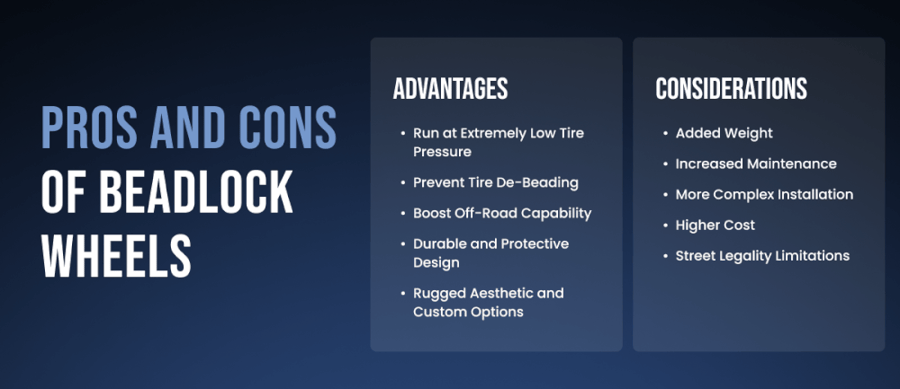
Like any modification, beadlock wheels come with both significant advantages and some notable trade-offs. Let’s break down the key pros and cons:
Advantages of Beadlock Wheels
Run at Extremely Low Tire Pressure
Beadlock wheels allow safe operation at very low air pressures—often down to 5 PSI or less. This dramatically increases traction by expanding the tire’s contact patch, especially on rocks, sand, and mud. Where standard wheels risk de-beading, beadlocks hold the tire securely in place, even under extreme terrain stress.
Prevent Tire De-Beading
Unlike conventional wheels that rely on air pressure alone, beadlocks use a mechanical ring to physically secure the tire bead. This prevents the tire from slipping or popping off during hard launches, sharp turns, or sudden impacts—critical in aggressive off-road or racing scenarios.
Boost Off-Road Capability
With tires locked to the wheel, drivers can tackle more technical terrain with confidence. Beadlocks enable traction and control that standard wheels can’t match, making them a go-to for rock crawlers, mud boggers, and desert racers who regularly push their vehicles to the limit.
Durable and Protective Design
Built for harsh use, beadlock wheels feature reinforced construction and a bolt-on ring that protects the wheel’s outer lip. Many designs allow the ring to be replaced independently, reducing long-term maintenance costs after heavy trail use or impacts.
Rugged Aesthetic and Custom Options
Beadlocks deliver a bold, functional look—visually distinct and performance-driven. Many models offer customizable rings in various colors or finishes, allowing enthusiasts to match their wheels to the overall design of their build without compromising utility.
Beadlock wheels offer exceptional benefits for off-road and high-performance applications. They provide unmatched control in demanding environments by enabling ultra-low tire pressures, improving traction, and physically securing the tire bead. Their rugged construction, added protection, and customizable design make them a top choice for enthusiasts pushing their builds beyond standard limits.
Considerations with Beadlock Wheels
Added Weight
Beadlocks are heavier than standard wheels due to their reinforced construction and bolted ring. This added unsprung weight can slightly reduce acceleration, braking efficiency, and fuel economy. While negligible for trail rigs, it’s a factor for daily drivers, especially if weight savings is a priority.
Increased Maintenance
Beadlock bolts must be checked and re-torqued regularly, especially after break-in or intense off-road use. Loose bolts can lead to air leaks or compromised clamping force. Unlike standard wheels, beadlocks require ongoing attention to stay secure and perform reliably.
More Complex Installation
Tire mounting is more involved. Each beadlock ring must be bolted down in sequence—adding time, cost, and effort. Balancing can also be more difficult due to the ring’s weight. Some shops may charge extra or decline beadlock service entirely, requiring off-road specialists or DIY solutions.
Higher Cost
Beadlocks generally cost more due to their advanced design and materials. Factor in not just the wheel price, but also potential added labor or maintenance expenses. If you’re budgeting a full build, this is an important line item to consider.
Street Legality Limitations
Most true beadlock wheels are not DOT-approved, making them technically illegal for highway use in many areas. Their multi-piece design also introduces added risk if not installed perfectly. For street-driven vehicles, this raises legal and safety considerations that shouldn’t be overlooked.
While beadlocks deliver serious performance, they also come with trade-offs. Added weight, maintenance requirements, more complex installation, and limited street legality may not suit every vehicle or driver. For those who drive primarily on pavement or prefer low-maintenance setups, it’s important to weigh these factors carefully before committing.
Street Use & Beadlock Alternatives
Beadlock wheels are built for the trail—but what happens when your build hits the pavement? Let’s break down the legal landscape, available options, and smarter alternatives for street-driven vehicles.
Street Legality: Know the Boundaries
Before installing beadlocks on a street-driven vehicle, it’s important to understand their legal limitations.
● Most aftermarket beadlock wheels are not DOT-approved and are clearly marked “for off-road use only.”
● Because they feature multi-piece construction, they haven’t been standardized for highway safety testing.
● Improper installation or hardware failure can lead to sudden air loss—a serious risk at road speeds.
● While enforcement can be inconsistent, running non-compliant wheels may still result in citations or complications with insurance in the event of an accident.
DOT-Approved & Dual-Purpose Designs
Some manufacturers now offer road-legal beadlocks and adaptable designs that close the gap between off-road performance and street compliance.
● Reversible systems let you switch between a standard street-safe configuration and a true beadlock setup for trail use.
● Factory options—like the Ford Raptor’s beadlock-capable wheels—combine rugged styling with legal usability.
● Additionally, an increasing number of beadlock models are being engineered to meet DOT standards, making them a smart choice for hybrid builds that see both dirt and daily miles.
Simulated Beadlocks: Off-Road Style, Street Simplicity
For drivers who want the aggressive beadlock aesthetic without the complexity, simulated beadlocks offer the perfect balance of form and function.
● These one-piece wheels feature cast-in bolt designs that replicate the rugged look of true beadlocks, without the need for additional hardware.
● These tires mount just like on any standard wheel, making installation straightforward.
● Simulated beadlocks are fully street legal, virtually maintenance-free, and available in a wide variety of sizes and finishes from trusted brands like Fuel, KMC, and Raceline.
Choosing What’s Right for You
Not every vehicle needs true beadlocks—and that’s okay. Here’s how to align your choice with your driving style:
● Use two wheel sets—beadlocks for trail days, conventional wheels for the commute.
● Consider simulated beadlocks if you want aggressive looks without extra upkeep.
● If your rig is built for serious off-road use and you’re comfortable with the trade-offs, stick with true bead locks.
How to Choose the Right Beadlock Wheels
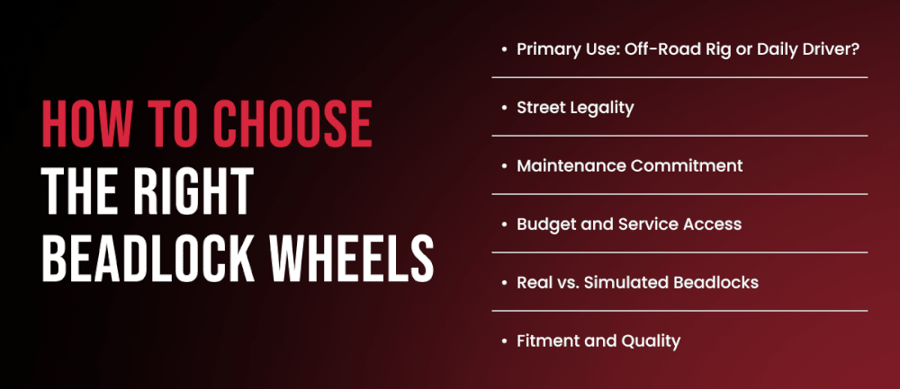
Selecting the right beadlock wheels means striking the right balance between your off-road goals and the practical realities of daily driving, maintenance, and budget. Here’s what to consider before committing:
Primary Use: Off-Road Rig or Daily Driver?
Start by assessing how you use your vehicle.
● Frequent pavement driving? Beadlocks may not be worth the trade-offs if you’re rarely airing down below 12–15 PSI.
● Serious trail use? If you’re crawling rocks, hitting deep ruts, or regularly airing down to single-digit PSI, beadlocks offer unmatched traction and tire security.
● In short: match your wheels to your driving habits. Off-road enthusiasts get the most from true beadlocks; casual users may be better served by conventional or simulated alternatives.
Street Legality
Check local regulations before running beadlocks on-road.
● Most beadlocks aren’t DOT-approved, making them technically illegal on highways in many areas.
● If legality is a concern, look for DOT-compliant beadlocks or stick to standard wheels for road use.
● When in doubt, play it safe and confirm what’s allowed in your region before hitting the street.
Maintenance Commitment
Beadlocks require routine attention—make sure you’re up for it.
● Expect regular bolt checks and torque adjustments to maintain clamping force.
● Great for hands-on owners who enjoy garage time, but not ideal for drivers seeking low-maintenance setups.
● Neglect can lead to air leaks or hardware failure—something no one wants mid-trail.
Budget and Service Access
Beyond upfront cost, beadlocks can carry ongoing expenses.
● They typically cost more than traditional wheels due to materials and construction.
● Tire mounting is more involved, and not all shops are willing to work on them.
● Ensure you have access to a beadlock-friendly shop or the tools and know-how to handle installs and maintenance yourself.
Real vs. Simulated Beadlocks
Not everyone needs a fully functional beadlock.
● If you want the look but drive mainly on-road or hit mild trails, simulated beadlocks offer the aesthetic without the upkeep.
● Save true beadlocks for builds where performance at low PSI truly matters.
● For daily drivers that only see dirt on weekends, simulated wheels are often the smart compromise.
Fitment and Quality
If you’re ready for beadlocks, make sure they fit your build properly.
● Double-check bolt pattern, diameter, width, and offset to ensure compatibility.
● Stick with reputable brands—engineering and build quality matter more than ever with beadlocks.
● AudioCityUSA carries only trusted beadlock options, so you can shop with confidence.
● Also confirm your tires are suitable for beadlock use, especially if you’re running oversized or specialty treads.
By weighing these key factors, you can decide whether beadlock wheels are the right fit for your needs and choose a set that delivers performance without compromise. Still unsure? Our experts at AudioCityUSA are always here to help you find the best solution for your build.
Up next: Let’s explore some top beadlock wheel options that are making waves in the off-road world.
Popular Beadlock Wheels and Brands
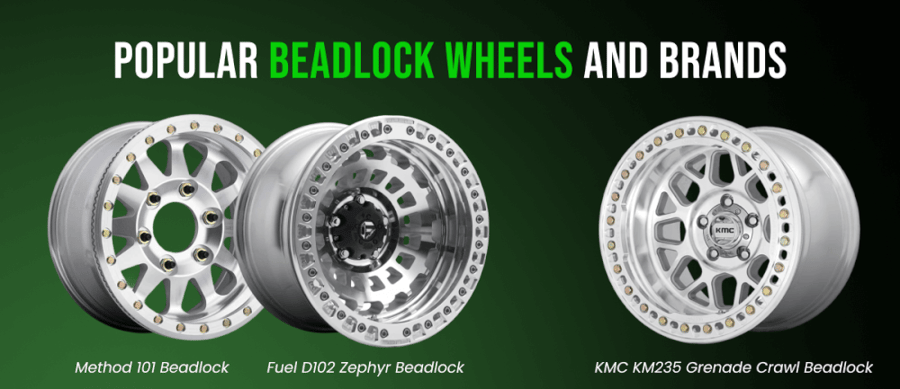
Thanks to their benefits, beadlock wheels are offered by many top manufacturers. Here are a few popular beadlock wheel options available at AudioCityUSA (with something for every style):
● Method 101 Beadlock : A race-proven icon from Method Race Wheels, the 101 features a lightweight yet durable A356 aluminum construction with proprietary heat treatment and a classic 12-bolt beadlock ring. Trusted by rock crawlers and desert racers alike, it delivers dependable performance at low PSI. If you want rugged reliability that’s lighter, stronger, faster—the 101 is it.
● KMC KM235 Grenade Crawl Beadlock; Built for serious trail use, the KM235 “Grenade Crawl” from KMC Wheels combines an aggressive split-spoke design with a reinforced 8-lug beadlock ring and bold industrial styling. Its 17×9 sizing and robust build make it a top pick for lifted Jeeps and trucks that demand performance and presence on rugged terrain.
● Fuel D102 Zephyr Beadlock; Modern, aggressive, and fully capable—the Fuel Zephyr (D102) blends striking multi-spoke styling with true beadlock performance. Featuring a 24-bolt ring and premium finishes in gloss black or machined accents, it’s built to turn heads and take a beating. A go-to for drivers seeking contemporary design without compromising off-road durability.
(Many other true beadlock models are available through AudioCityUSA in various sizes, bolt patterns, and finishes to suit different vehicles. Ensure any beadlock rims you choose meet your vehicle’s requirements and your performance needs. If you need help, our specialists can point you to the ideal options from brands like Black Rhino, Raceline, Dirty Life, and more.)
Final Thoughts
Beadlock wheels are a powerful upgrade for off-road and high-performance builds—offering grip, control, and protection that standard wheels can’t match in extreme conditions. By physically locking the tire to the rim, they enable confident performance at low PSI, giving serious drivers a clear edge on tough terrain.
While beadlocks come with added weight, maintenance, and cost, the trade-off is often well worth it for those who regularly push their vehicles off-road or compete in demanding environments. Just be sure you understand their limitations, particularly for street use, and stay on top of routine care.
If your adventures include rock crawling, desert runs, or trail work, a quality set of beadlocks can be a game-changer. For everyday driving or light off-roading, simulated beadlocks may offer a more practical solution with the same bold aesthetic.
At AudioCityUSA, we offer a curated selection of true beadlock and beadlock-style wheels from the industry’s leading brands. With over 30 years of experience, we’re here to help you find the right fitment, style, and performance for your build—whether it’s a Jeep, truck, UTV, or beyond.
Upgrade with confidence, drive with purpose, and unleash your build’s full potential. With the right beadlock wheels, you’re ready for anything the trail—or the track—throws your way.
